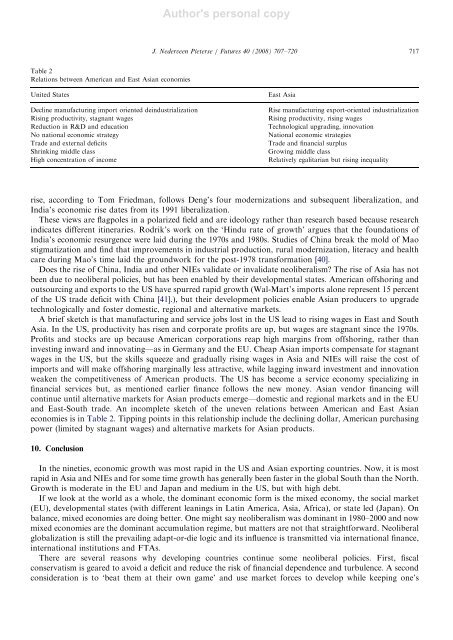New Glob Fu JFTR1275.pdf - Jan Nederveen Pieterse
New Glob Fu JFTR1275.pdf - Jan Nederveen Pieterse
New Glob Fu JFTR1275.pdf - Jan Nederveen Pieterse
You also want an ePaper? Increase the reach of your titles
YUMPU automatically turns print PDFs into web optimized ePapers that Google loves.
Author's personal copy<br />
ARTICLE IN PRESS<br />
J. <strong>Nederveen</strong> <strong>Pieterse</strong> / <strong>Fu</strong>tures 40 (2008) 707–720 717<br />
Table 2<br />
Relations between American and East Asian economies<br />
United States<br />
Decline manufacturing import oriented deindustrialization<br />
Rising productivity, stagnant wages<br />
Reduction in R&D and education<br />
No national economic strategy<br />
Trade and external deficits<br />
Shrinking middle class<br />
High concentration of income<br />
East Asia<br />
Rise manufacturing export-oriented industrialization<br />
Rising productivity, rising wages<br />
Technological upgrading, innovation<br />
National economic strategies<br />
Trade and financial surplus<br />
Growing middle class<br />
Relatively egalitarian but rising inequality<br />
rise, according to Tom Friedman, follows Deng’s four modernizations and subsequent liberalization, and<br />
India’s economic rise dates from its 1991 liberalization.<br />
These views are flagpoles in a polarized field and are ideology rather than research based because research<br />
indicates different itineraries. Rodrik’s work on the ‘Hindu rate of growth’ argues that the foundations of<br />
India’s economic resurgence were laid during the 1970s and 1980s. Studies of China break the mold of Mao<br />
stigmatization and find that improvements in industrial production, rural modernization, literacy and health<br />
care during Mao’s time laid the groundwork for the post-1978 transformation [40].<br />
Does the rise of China, India and other NIEs validate or invalidate neoliberalism? The rise of Asia has not<br />
been due to neoliberal policies, but has been enabled by their developmental states. American offshoring and<br />
outsourcing and exports to the US have spurred rapid growth (Wal-Mart’s imports alone represent 15 percent<br />
of the US trade deficit with China [41].), but their development policies enable Asian producers to upgrade<br />
technologically and foster domestic, regional and alternative markets.<br />
A brief sketch is that manufacturing and service jobs lost in the US lead to rising wages in East and South<br />
Asia. In the US, productivity has risen and corporate profits are up, but wages are stagnant since the 1970s.<br />
Profits and stocks are up because American corporations reap high margins from offshoring, rather than<br />
investing inward and innovating—as in Germany and the EU. Cheap Asian imports compensate for stagnant<br />
wages in the US, but the skills squeeze and gradually rising wages in Asia and NIEs will raise the cost of<br />
imports and will make offshoring marginally less attractive, while lagging inward investment and innovation<br />
weaken the competitiveness of American products. The US has become a service economy specializing in<br />
financial services but, as mentioned earlier finance follows the new money. Asian vendor financing will<br />
continue until alternative markets for Asian products emerge—domestic and regional markets and in the EU<br />
and East-South trade. An incomplete sketch of the uneven relations between American and East Asian<br />
economies is in Table 2. Tipping points in this relationship include the declining dollar, American purchasing<br />
power (limited by stagnant wages) and alternative markets for Asian products.<br />
10. Conclusion<br />
In the nineties, economic growth was most rapid in the US and Asian exporting countries. Now, it is most<br />
rapid in Asia and NIEs and for some time growth has generally been faster in the global South than the North.<br />
Growth is moderate in the EU and Japan and medium in the US, but with high debt.<br />
If we look at the world as a whole, the dominant economic form is the mixed economy, the social market<br />
(EU), developmental states (with different leanings in Latin America, Asia, Africa), or state led (Japan). On<br />
balance, mixed economies are doing better. One might say neoliberalism was dominant in 1980–2000 and now<br />
mixed economies are the dominant accumulation regime, but matters are not that straightforward. Neoliberal<br />
globalization is still the prevailing adapt-or-die logic and its influence is transmitted via international finance,<br />
international institutions and FTAs.<br />
There are several reasons why developing countries continue some neoliberal policies. First, fiscal<br />
conservatism is geared to avoid a deficit and reduce the risk of financial dependence and turbulence. A second<br />
consideration is to ‘beat them at their own game’ and use market forces to develop while keeping one’s





